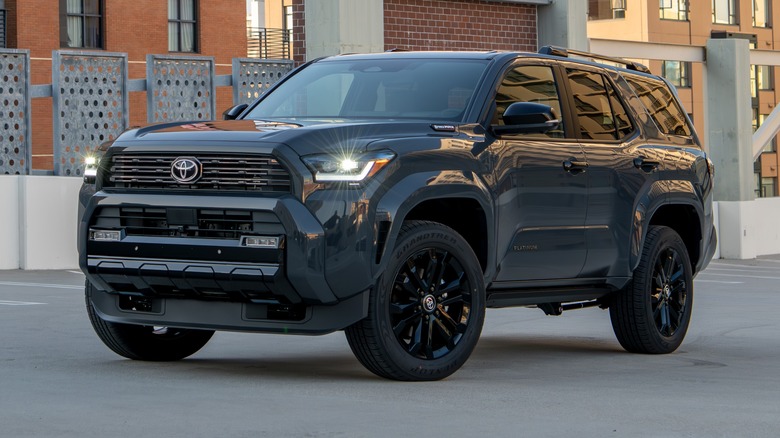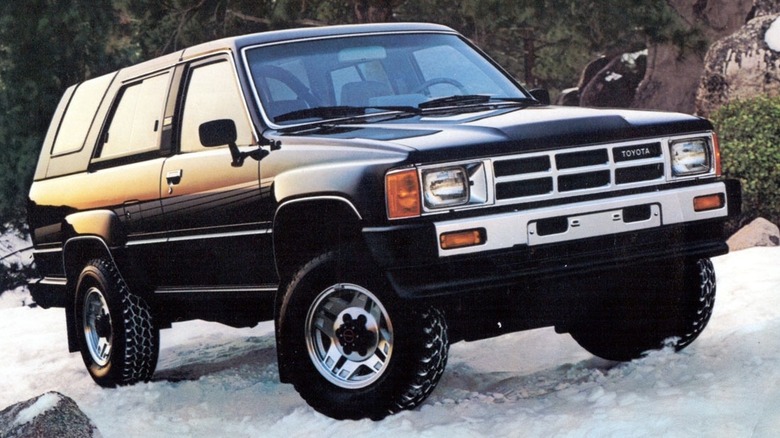Are The 2025 Toyota 4Runner And Tacoma Built On The Same Platform?
Platform sharing happens a lot in the car industry, as building two or more cars on the same chassis helps reduce costs. Toyota does this a lot. Take the GA-K platform, for example. It currently underpins the Toyota Camry, RAV4, Highlander, and Sienna, among many other unibody Toyota models. Given Toyota's history of using the same platform for many of its cars, it makes sense to ask whether the Tacoma and 4Runner use the same platform.
Well, the short answer is actually yes — the Tacoma and 4Runner are closely related to each other. The current fourth-gen Tacoma and sixth-generation 4Runner are built on Toyota's GA-F platform, which also underpins other vehicles such as the very capable Lexus GX 550, fourth-generation Lexus LX, as well as the fifth-generation Toyota Land Cruiser Prado.
The base powerplant for both the Tacoma and 4Runner is a 2.4-liter turbocharged 4-cylinder i-Force engine that produces 278 hp and 317 lb-ft of torque in the 4Runner, as well as 228 hp and 243 lb-ft of torque in the entry-level Tacoma. In higher Tacoma models, it generates 270 or 278 hp and 310 or 317 lb-ft, depending on whether you pair the engine with an available six-speed manual transmission or the standard eight-speed automatic. The 4Runner offers only the eight-speed automatic across all trims.
If you want more horsepower, you can upgrade to the more robust Toyota i-Force Max hybrid mill, which marries the 2.4-liter turbocharged 4-cylinder with a 48-hp electric motor for 326 hp and 465 lb-ft in both models.
The Tacoma and 4Runner didn't always share a platform
Although the Toyota 4Runner and Tacoma have often shared a number of commonalities since the latter made its debut in 1995, there have been moments when the 4Runner was more closely related to other Toyota models. Following its debut in 1984, the first two 4Runner generations were based on the Toyota Hilux platform. For its third generation, which was produced from 1996 through 2002, Toyota built the 4Runner on the Land Cruiser Prado chassis as part of efforts to move the SUV away from its truck roots and provide buyers with a more luxurious driving experience.
But, as it turns out, that moment marked the beginning of the faithful companionship between the Tacoma and 4Runner, as the third-gen 4Runner model was available with a 3.4-liter V6 and a 2.7-liter inline-four that were also offered on the first-generation Toyota Tacoma. Like the third-generation, fourth- and fifth-generation 4Runner models were also based on the Land Cruiser Prado platform.
Specs and pricing for the Tacoma and 4Runner
Alongside the platform, the current sixth-gen Toyota 4Runner and fourth-generation Tacoma also share similar features. Base models of both come standard with an 8.0-inch touchscreen infotainment system with wireless Apple CarPlay and Android Auto connectivity. The two also have 17-inch wheels in their base trims, although the 4Runner comes with alloy wheels as standard, whereas the Tacoma has steel ones.
The 4Runner and Tacoma can also be equipped almost identically in higher trims, with heated and ventilated front seats, a heated steering wheel, a 14-inch infotainment touchscreen, a head-up display, and a wireless smartphone charger all being available. That being said, the 4Runner is more expensive than its truck sibling, which shouldn't come as a total surprise, considering it is more luxurious overall.
The entry-level 4Runner SR5 costs from $40,770 before a $1,450 destination charge is applied. That price makes it about $9,180 costlier than the base Toyota Tacoma SR, which starts at $31,590 before the mandatory $1,495 destination fee. At the higher end, the Tacoma costs $63,735 (before destination) in its costliest guise, the TRD Pro i-FORCE MAX, whereas the 4Runner goes as high as $66,900 for the range-topping 4Runner TRD Pro i-FORCE MAX (also before destination).


